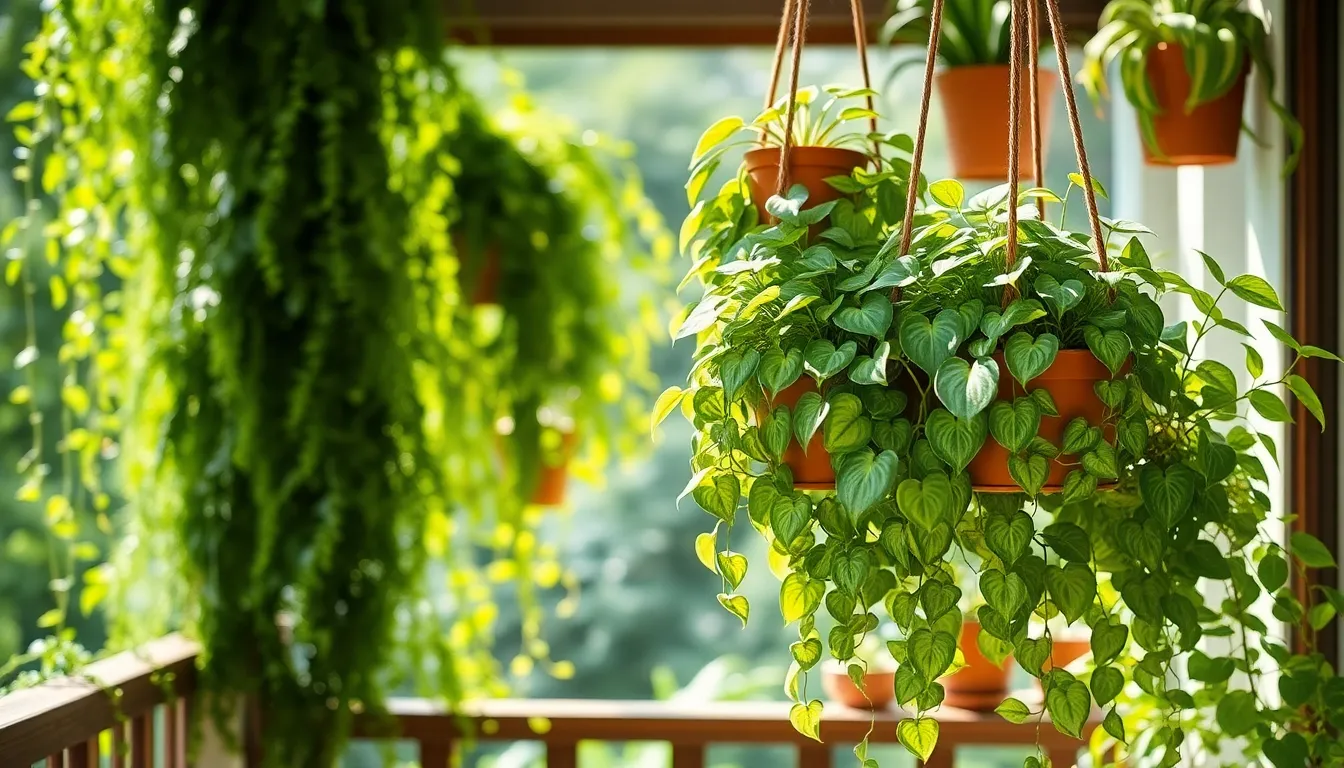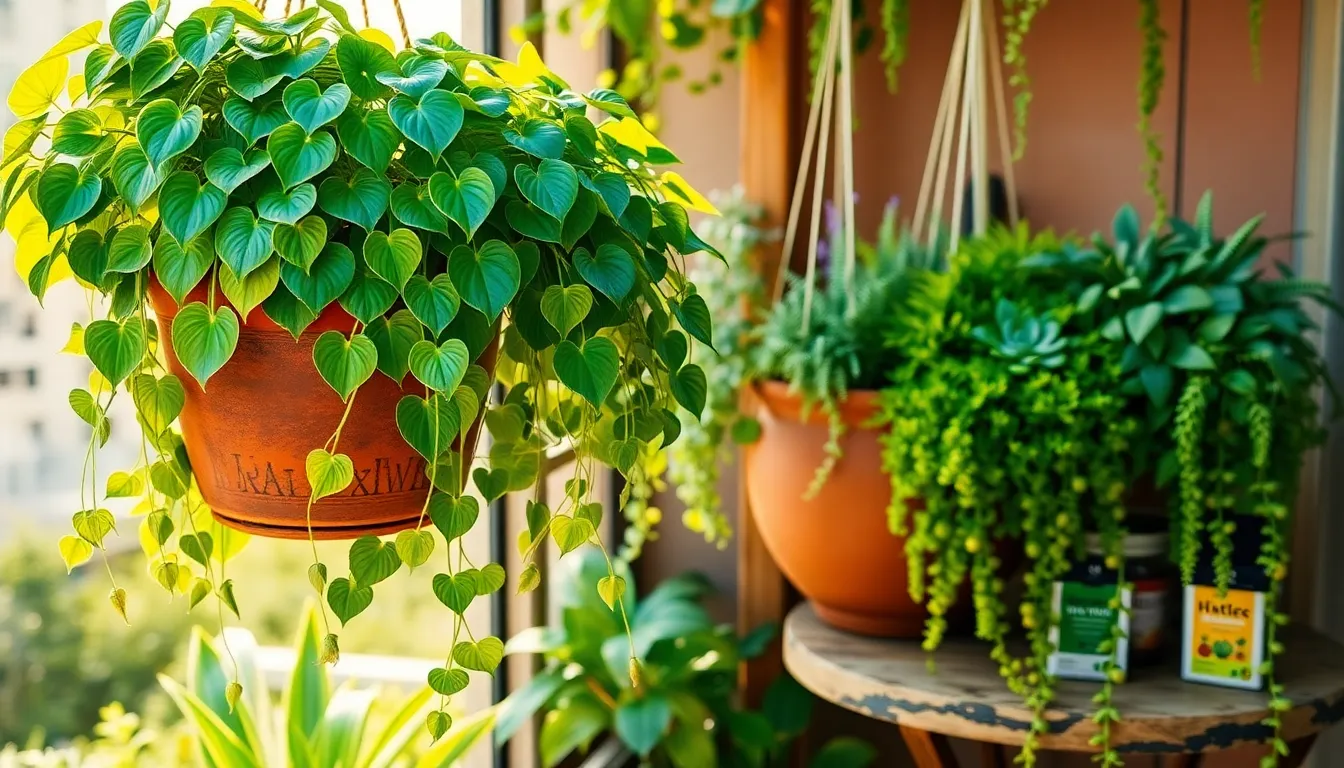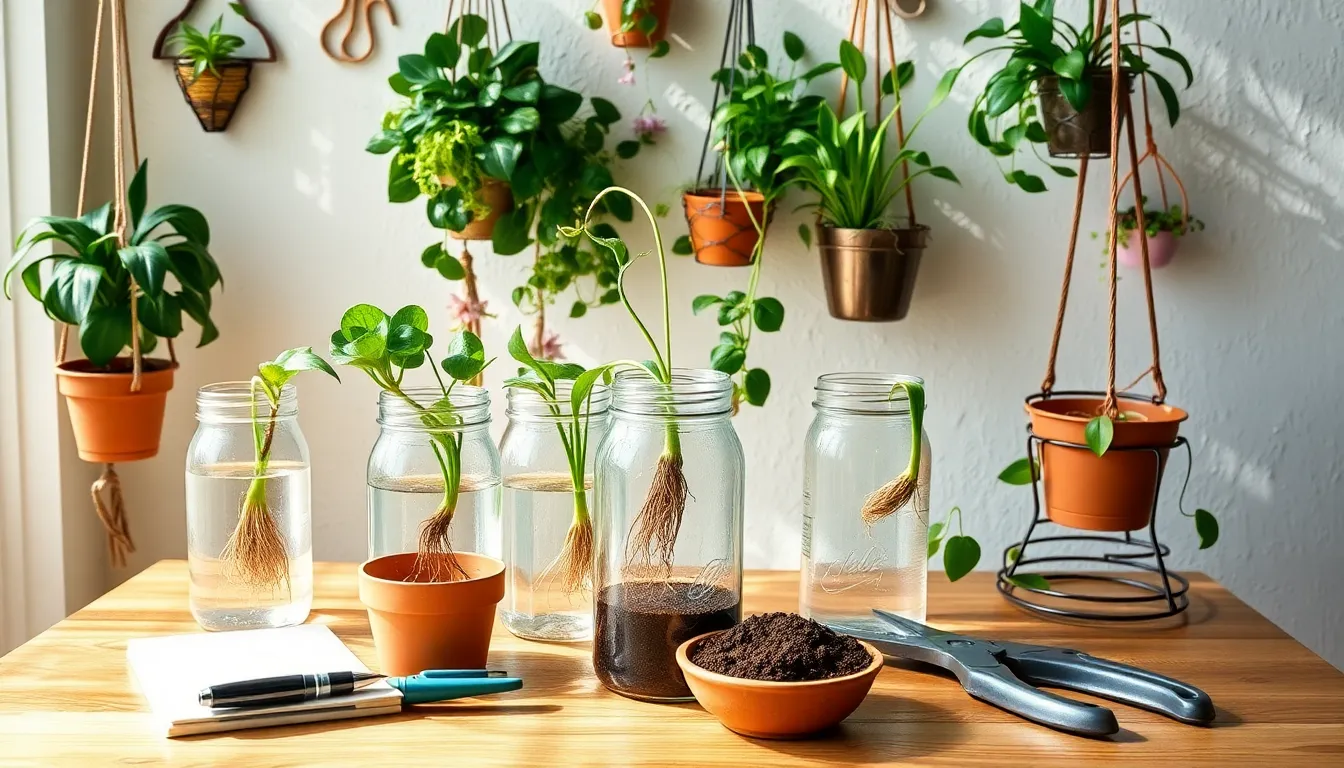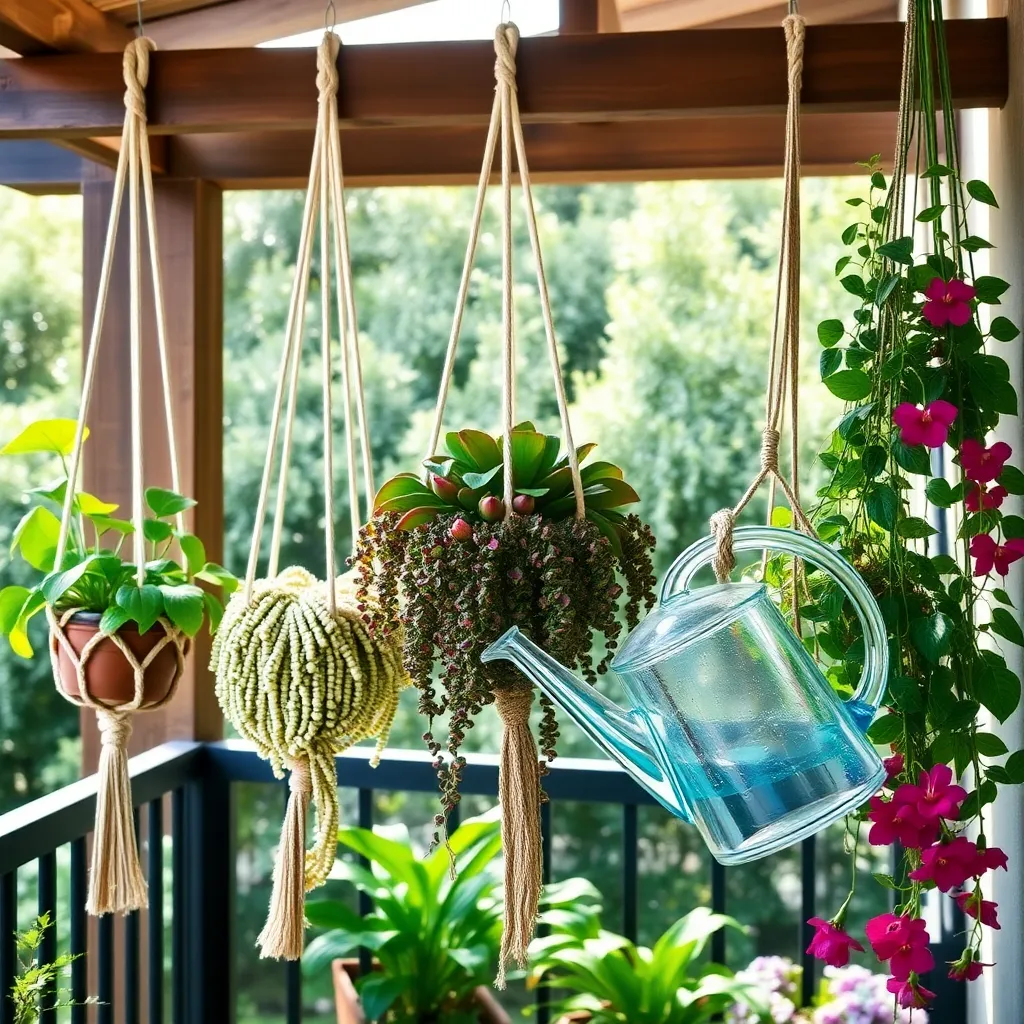Welcome to the lush world of hanging plants, where your gardening dreams can defy gravity and bring vibrant life to any space. Whether you’re just beginning your gardening journey or have years of experience under your belt, this guide to 18 eye-catching hanging plants is your ticket to transforming your indoor sanctuary into a verdant paradise.
In this curated collection, you’ll discover a diversity of plants that offer more than just aesthetic appeal—they clean the air, boost your mood, and can even inspire your creativity. Our guide is crafted to empower you with practical tips and insights, ensuring that you can nurture these plants with confidence and watch them thrive.
Imagine the joy of stepping into a room enlivened by cascading greenery and the satisfaction of knowing you cultivated it yourself. With this guide in hand, you’ll not only enhance your living space but also walk away with the rewarding skills of a successful indoor gardener.
Understanding Hanging Plant Benefits
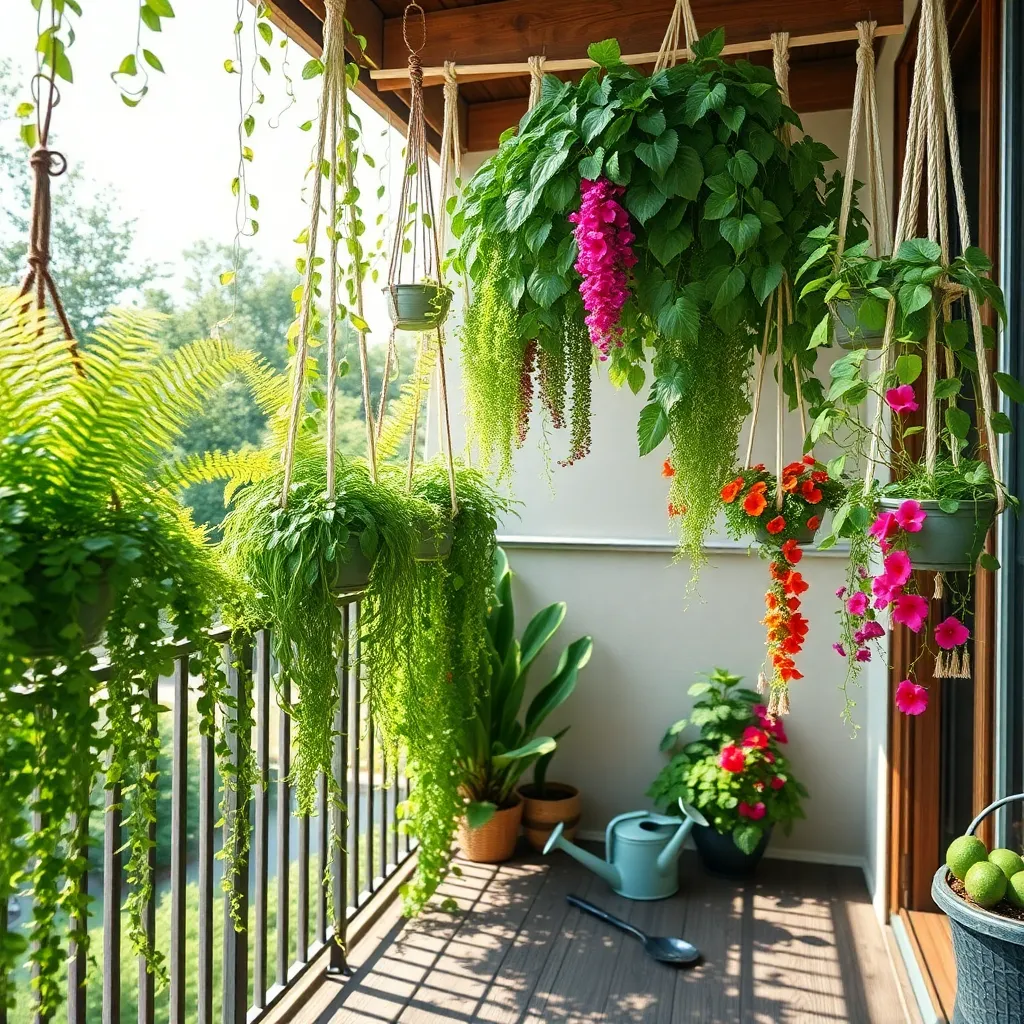
Hanging plants offer a unique way to utilize vertical space, making them ideal for small gardens or urban settings. They can transform balconies, patios, and even indoor areas into lush, green retreats with minimal ground space required.
Beyond aesthetics, hanging plants can improve air quality by filtering pollutants and releasing oxygen. This makes them not only a decorative choice but also a functional one, particularly beneficial in urban environments where air quality may be compromised.
For beginners, selecting the right type of plant for your hanging display is crucial for success. Opt for plants like spider plants or pothos, which are known for their resilience and adaptability to various light conditions.
More experienced gardeners might experiment with a variety of species to create a dynamic visual impact. Consider mixing plants with different leaf shapes and colors to add texture and interest to your hanging garden.
Proper care is essential to keep hanging plants thriving; ensure they have adequate drainage and use a lightweight potting mix that retains moisture without becoming waterlogged. Watering frequency can vary based on plant type and location, but a general rule is to check moisture levels by sticking your finger into the soil; water when the top inch feels dry.
To further enhance plant health, fertilize during the growing season using a balanced, water-soluble fertilizer. Hanging plants often need more frequent feeding due to increased exposure to air and sunlight, which can deplete nutrients faster than in-ground plants.
Choosing the Perfect Plant Varieties
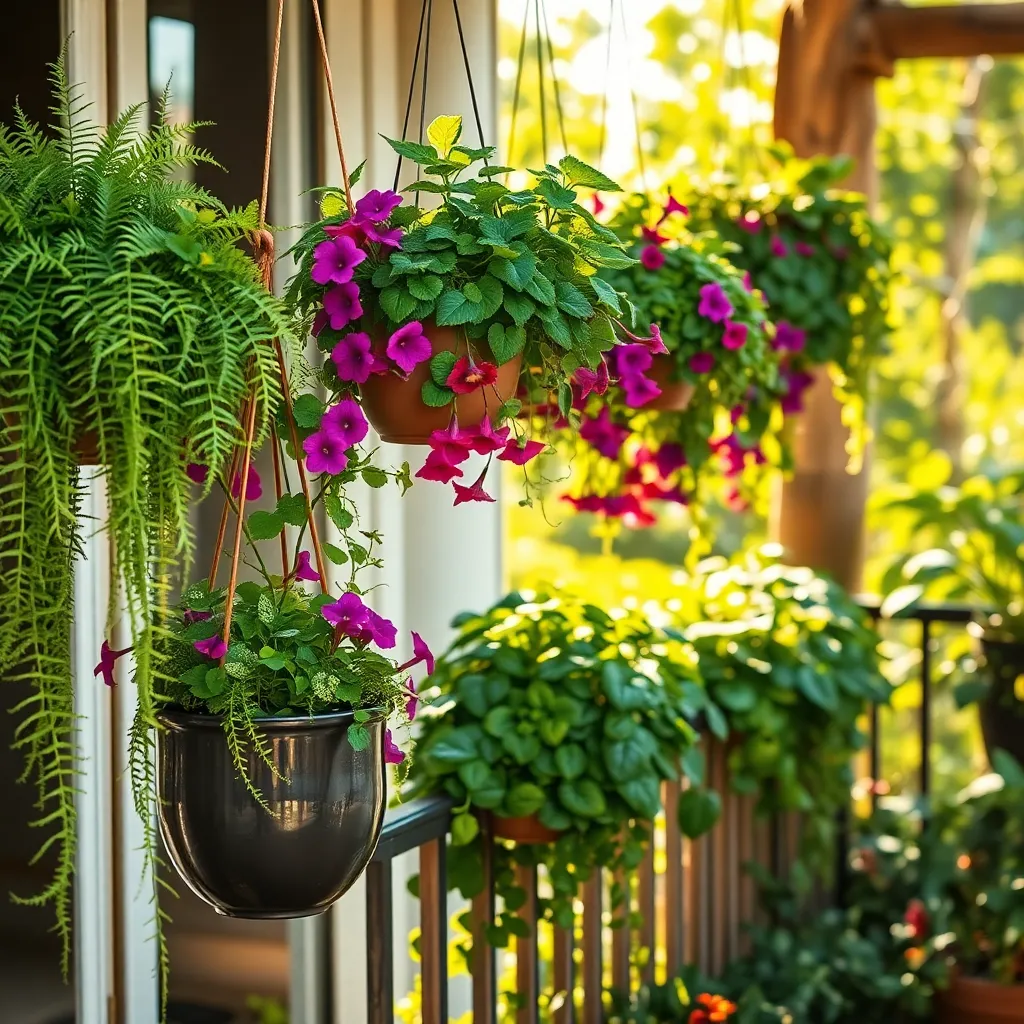
When choosing the perfect plant varieties for your hanging garden, consider the specific lighting conditions of your space. Bright, indirect light is ideal for many popular hanging plants, like pothos and philodendrons, which thrive with moderate sunlight exposure.
For those with less light, opt for plants like the Spider Plant or Boston Fern, which can tolerate lower light levels. These varieties still require regular watering, but make sure to allow excess water to drain to prevent root rot.
Think about your schedule and how much time you can dedicate to plant care. If you prefer a low-maintenance option, consider succulents like String of Pearls, which only need watering every two weeks and thrive in well-draining soil.
For more advanced gardeners, experimenting with flowering hanging plants like Fuchsia can be rewarding. These plants require more attention, including regular feeding with a balanced fertilizer and consistent deadheading to promote blooms.
Boston Fern: A Classic Choice
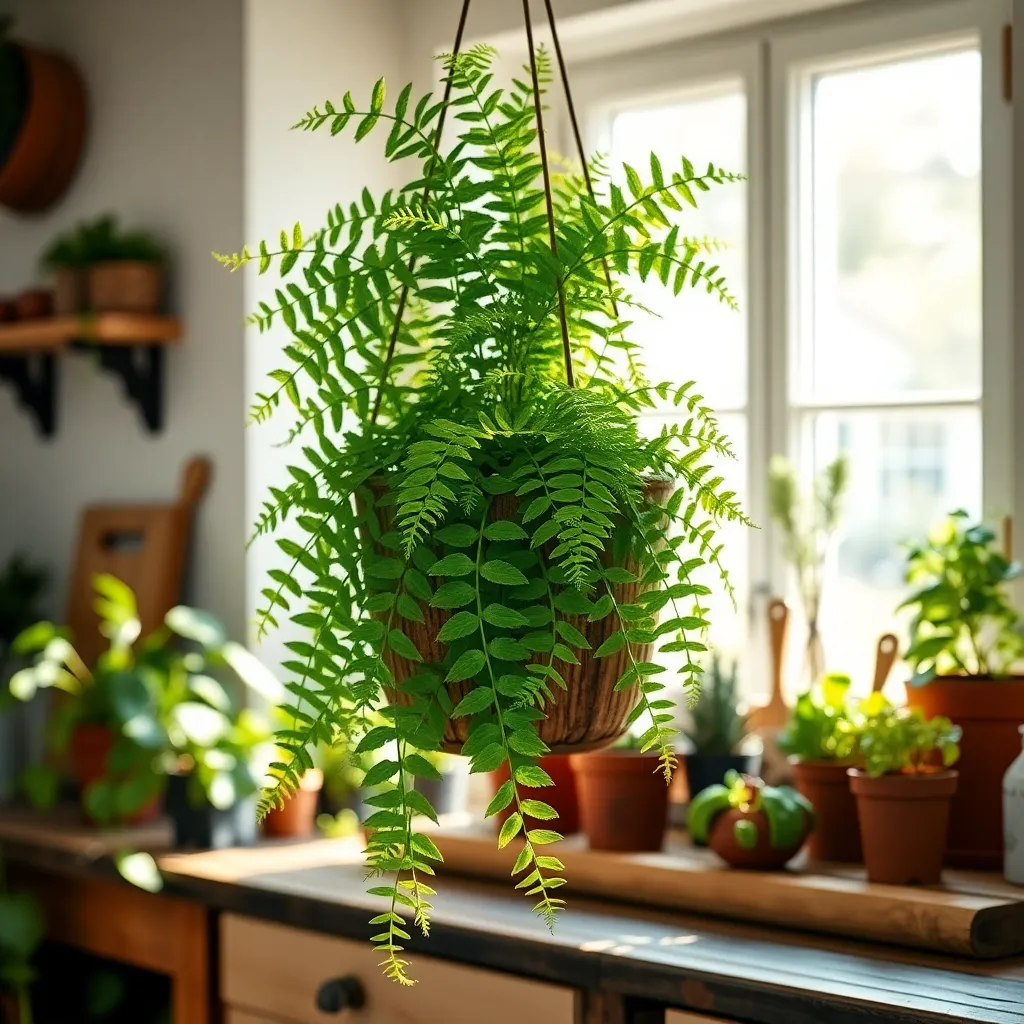
The Boston Fern is a timeless choice for hanging baskets, offering lush greenery that can transform any space. This plant thrives in indirect light, making it perfect for indoor locations or shaded outdoor areas.
To ensure your Boston Fern flourishes, water it regularly but avoid allowing the soil to become waterlogged. A consistent watering schedule, such as checking the soil moisture every few days, will help keep this plant healthy and vibrant.
A crucial aspect of Boston Fern care is maintaining high humidity levels, as these ferns are native to tropical climates. You can increase humidity by misting the plant daily or placing a humidifier nearby.
Advanced gardeners can enhance the fern’s growth by using a balanced liquid fertilizer every 4-6 weeks during the growing season. Additionally, consider repotting your fern in a well-draining potting mix rich in organic matter to support its development.
String of Pearls: Unique Aesthetics
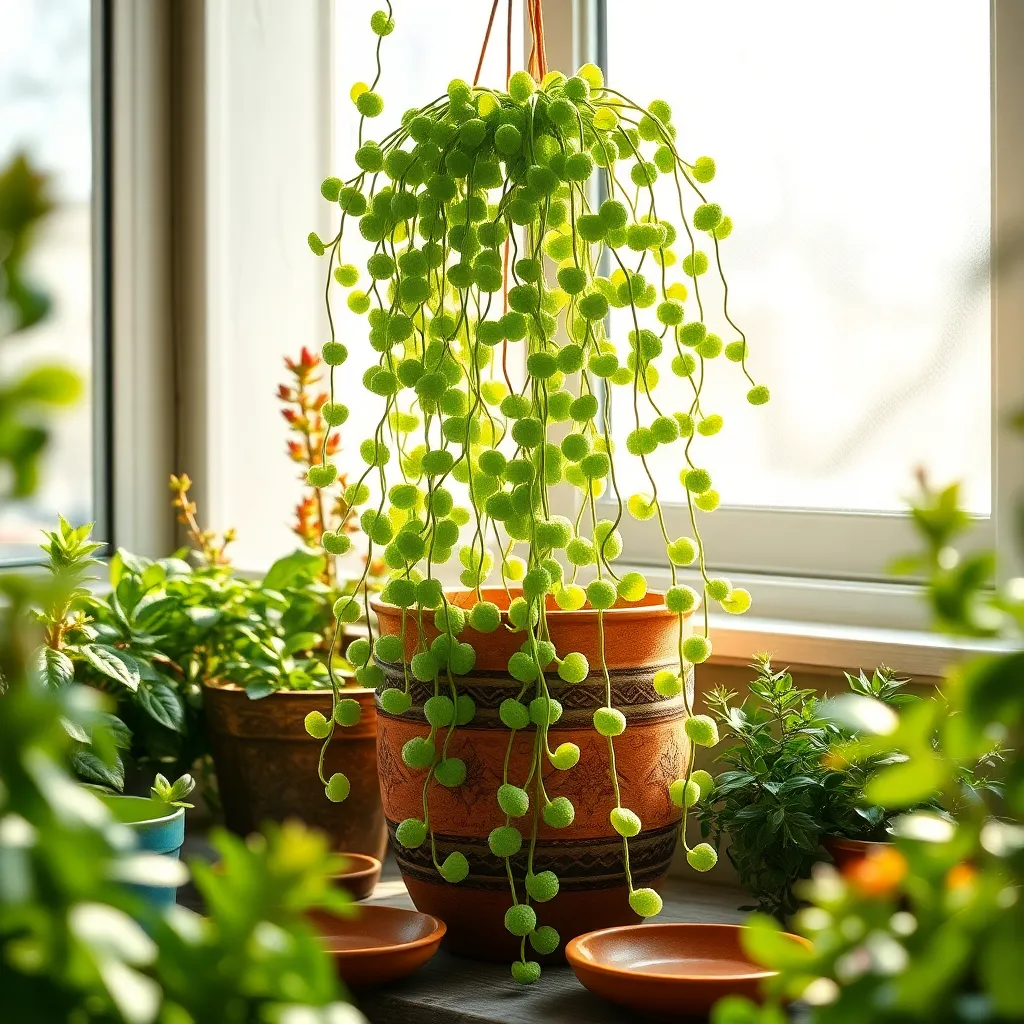
The String of Pearls (Senecio rowleyanus) is a captivating succulent known for its distinctive appearance. Its trailing stems adorned with small, spherical leaves resemble a cascade of green pearls, making it an excellent choice for hanging baskets.
To successfully grow a String of Pearls, ensure it receives bright, indirect light to maintain its vibrant color and robust growth. Direct sunlight can scorch the leaves, so place it near a window with filtered light or use sheer curtains to diffuse the light.
Watering is crucial, as this plant is susceptible to overwatering. Allow the soil to dry out completely between waterings, typically every two to three weeks, and use a well-draining cactus or succulent mix to prevent root rot.
For more advanced care, consider propagating your String of Pearls by taking cuttings and allowing them to dry for a day before planting in soil. This succulent thrives in environments with controlled humidity, so it’s ideal for indoor settings where humidity levels can be easily managed.
Spider Plant: Low-Maintenance Beauty
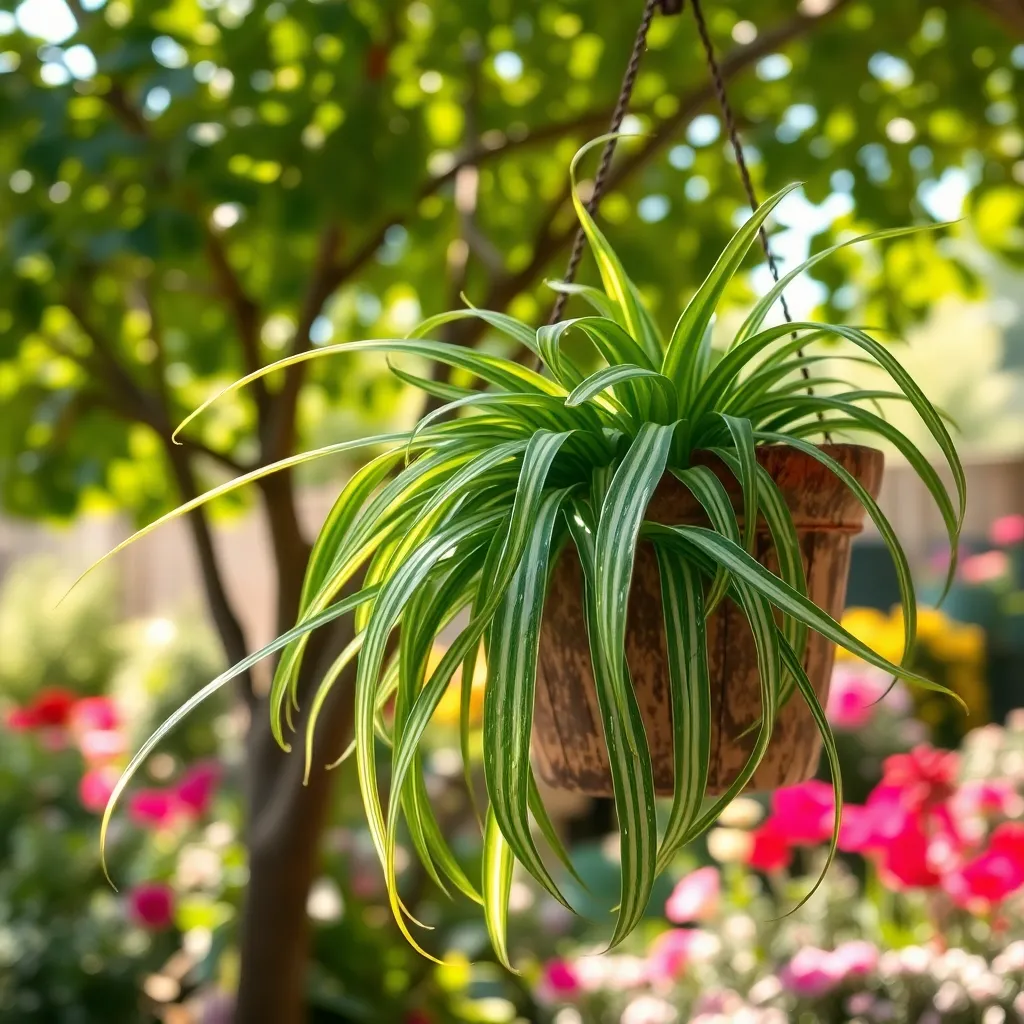
Spider plants are an excellent choice for those seeking a low-maintenance hanging beauty. Known for their arching leaves and charming offshoots, they add a lush, natural elegance to any space.
To keep your spider plant thriving, place it in indirect sunlight, as direct rays can scorch its leaves. Water it moderately, allowing the soil to dry out slightly between waterings to prevent root rot.
Spider plants prefer a well-draining potting mix; an all-purpose soil with added perlite works well. They are also highly adaptable to varying indoor conditions, making them perfect for beginners and those with less time for plant care.
For more advanced care, consider fertilizing your spider plant monthly during the growing season with a balanced, liquid fertilizer. Additionally, you can propagate new plants easily by planting the offshoots, known as “spiderettes,” in fresh soil.
Golden Pothos: Versatile and Vibrant

Golden Pothos, also known as Devil’s Ivy, is a highly adaptable plant that thrives in a variety of environments. It is perfect for beginners, as it can tolerate low light conditions and irregular watering, making it a low-maintenance choice for hanging baskets.
When caring for Golden Pothos, it’s essential to use well-draining soil to prevent root rot. A mixture of potting soil, perlite, and orchid bark can provide the perfect balance of aeration and moisture retention.
Watering should be done sparingly, allowing the top inch of soil to dry out between waterings. This plant is forgiving if you forget to water it occasionally, but overwatering should be avoided to keep it healthy.
For those looking to promote lush growth, consider fertilizing every 4-6 weeks during the growing season with a balanced liquid fertilizer. Trimming back leggy vines will not only keep your Golden Pothos looking tidy but also encourage the plant to grow fuller and bushier.
Trailing Jade: Succulent Elegance
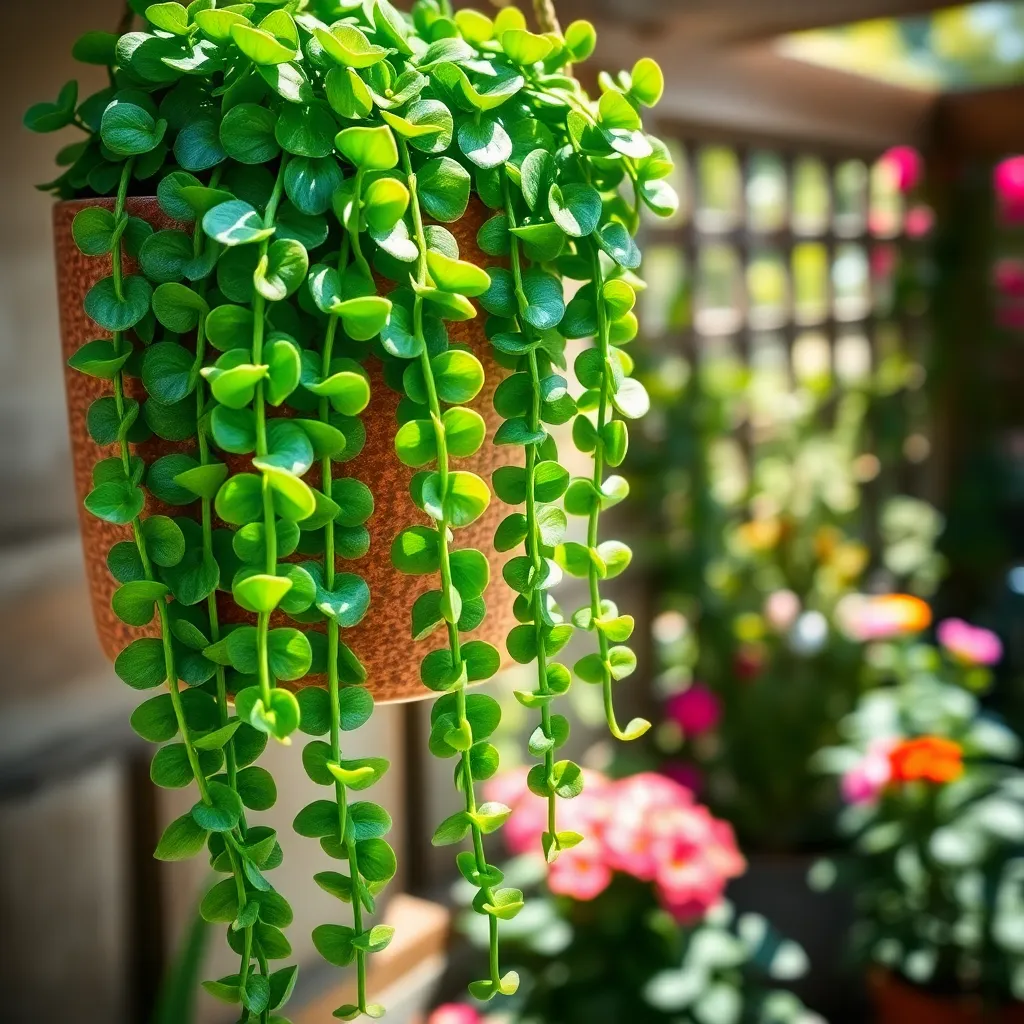
Trailing Jade, known scientifically as Senecio jacobsenii, offers both beauty and low-maintenance charm for hanging planters. This succulent is ideal for beginners due to its minimal water requirements and ability to thrive in a variety of light conditions.
When planting Trailing Jade, use a well-draining cactus or succulent soil mix to prevent root rot. Ensure the pot has adequate drainage holes, as excess water is the most common cause of succulent failure.
Position your Trailing Jade where it receives bright, indirect sunlight, which promotes healthy growth and vibrant coloring. If grown indoors, consider placing it near a south or east-facing window to maximize light exposure.
Watering should be done sparingly, typically every two to three weeks, allowing the soil to dry out completely between waterings. During winter months, reduce the frequency even further, as the plant’s growth slows and its water needs diminish.
- Use diluted, balanced liquid fertilizer during the growing season for additional nutrients.
- Prune periodically to encourage bushier growth and to remove any dead or leggy stems.
For more advanced care, consider repotting your Trailing Jade every two to three years to refresh the soil and provide room for growth. With a little care, this elegant succulent can become a stunning focal point in your collection of hanging plants.
English Ivy: Classic Greenery
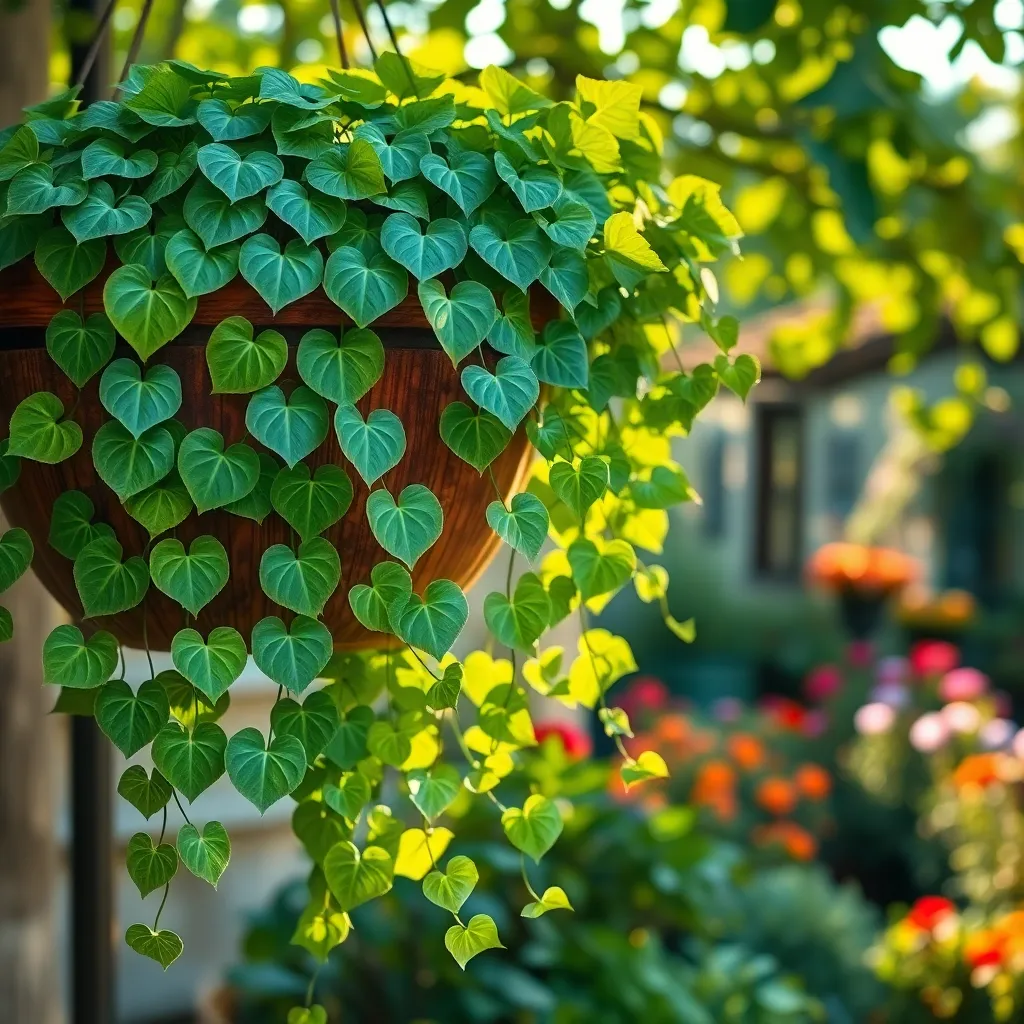
English Ivy, with its lush, trailing vines, brings a touch of timeless elegance to any space. This hardy plant thrives in a range of conditions, making it perfect for both indoor and outdoor hanging baskets.
To ensure your English Ivy flourishes, plant it in well-draining soil such as a mix of potting soil and perlite. Regular watering is essential, but be cautious not to overwater; allow the top inch of soil to dry out between waterings.
For optimal growth, place your ivy in a location with bright, indirect light. While tolerant of lower light conditions, more light encourages denser foliage and faster growth.
Pruning is key to maintaining its shape and promoting bushier growth. Snip back any leggy stems, and consider using the cuttings to propagate new plants—simply place them in water until roots form, then transfer to soil.
Burro’s Tail: Sedum Sensation
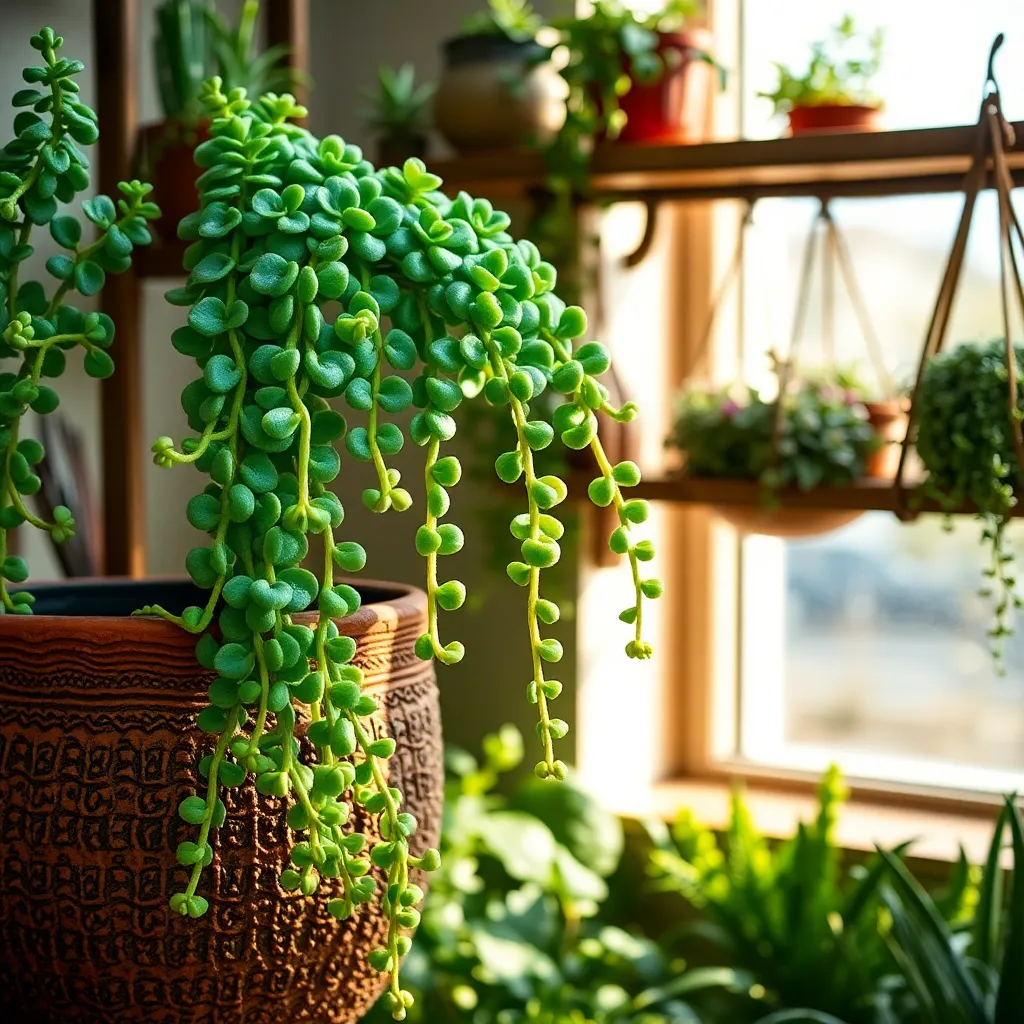
Burro’s Tail, known scientifically as Sedum morganianum, is a delightful succulent that makes a stunning hanging plant. Its trailing stems adorned with fleshy, blue-green leaves create a cascading effect that’s perfect for adding texture to your space.
For optimal growth, place your Burro’s Tail in a location where it will receive bright, indirect sunlight. Direct sunlight can scorch the leaves, so a spot near a window with filtered light is ideal.
When it comes to watering, be sure to let the soil dry out completely between waterings to prevent root rot. During the growing season, watering every two weeks is generally sufficient, but adjust according to your climate and the plant’s needs.
Ensure your Burro’s Tail thrives by planting it in a well-draining soil mix, such as a cactus or succulent blend. Adding some sand or perlite can improve drainage further, helping to keep the roots healthy and happy.
Maidenhair Fern: Delicate Fronds
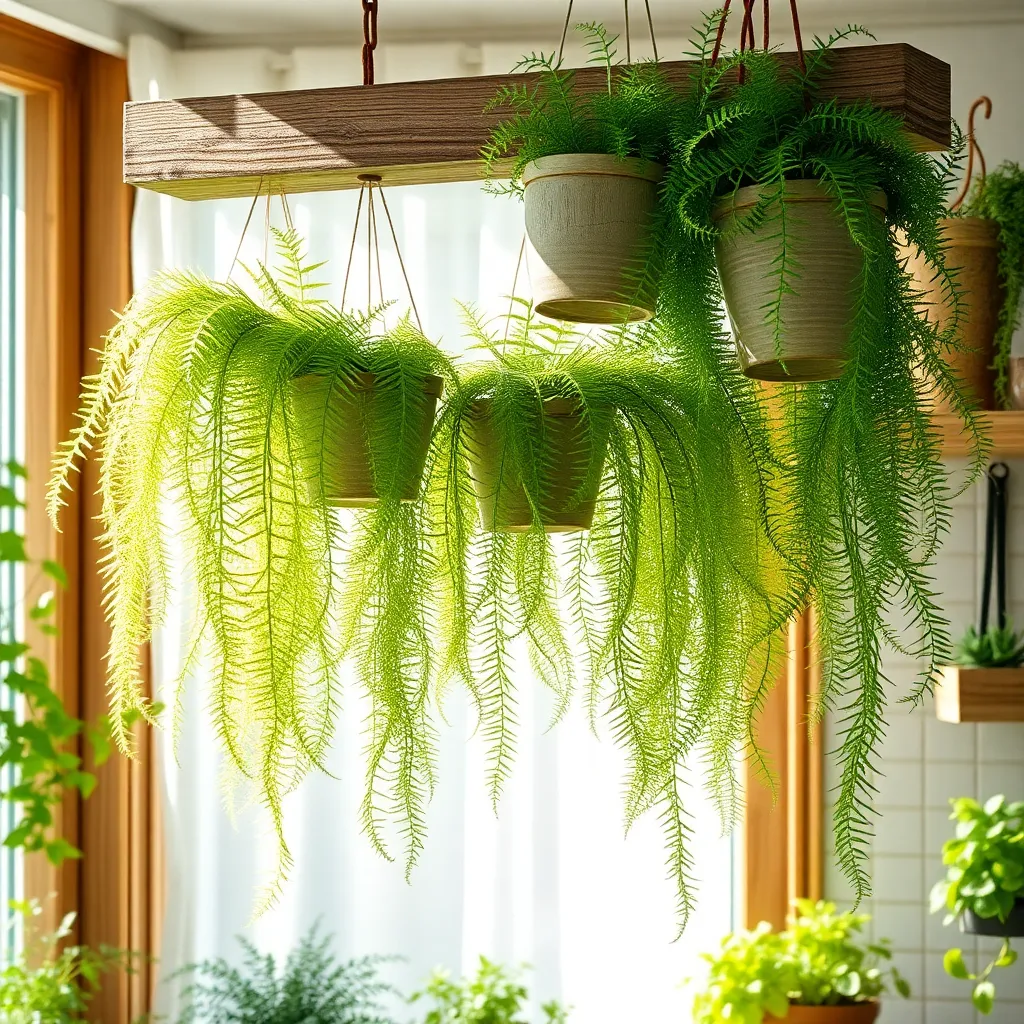
Maidenhair Fern, with its delicate, lacy fronds, makes a stunning addition to any hanging plant collection. To thrive, it requires a humid environment, making it an ideal choice for bathrooms or kitchens where moisture levels are naturally higher.
When it comes to watering, ensure the soil remains consistently moist but not waterlogged. A good practice is to use a well-draining potting mix that includes ingredients like peat moss and perlite to maintain the right balance of moisture and airflow.
These ferns prefer indirect sunlight, as direct exposure can scorch their delicate leaves. Position your Maidenhair Fern near an east or north-facing window, or filter the light with a sheer curtain if the plant is closer to stronger sunlight.
For advanced care, mist your fern regularly to mimic its natural humid environment. Additionally, feeding the plant with a diluted liquid fertilizer every 4-6 weeks during the growing season will promote lush growth and help maintain its vibrant green color.
Heartleaf Philodendron: Lush Growth
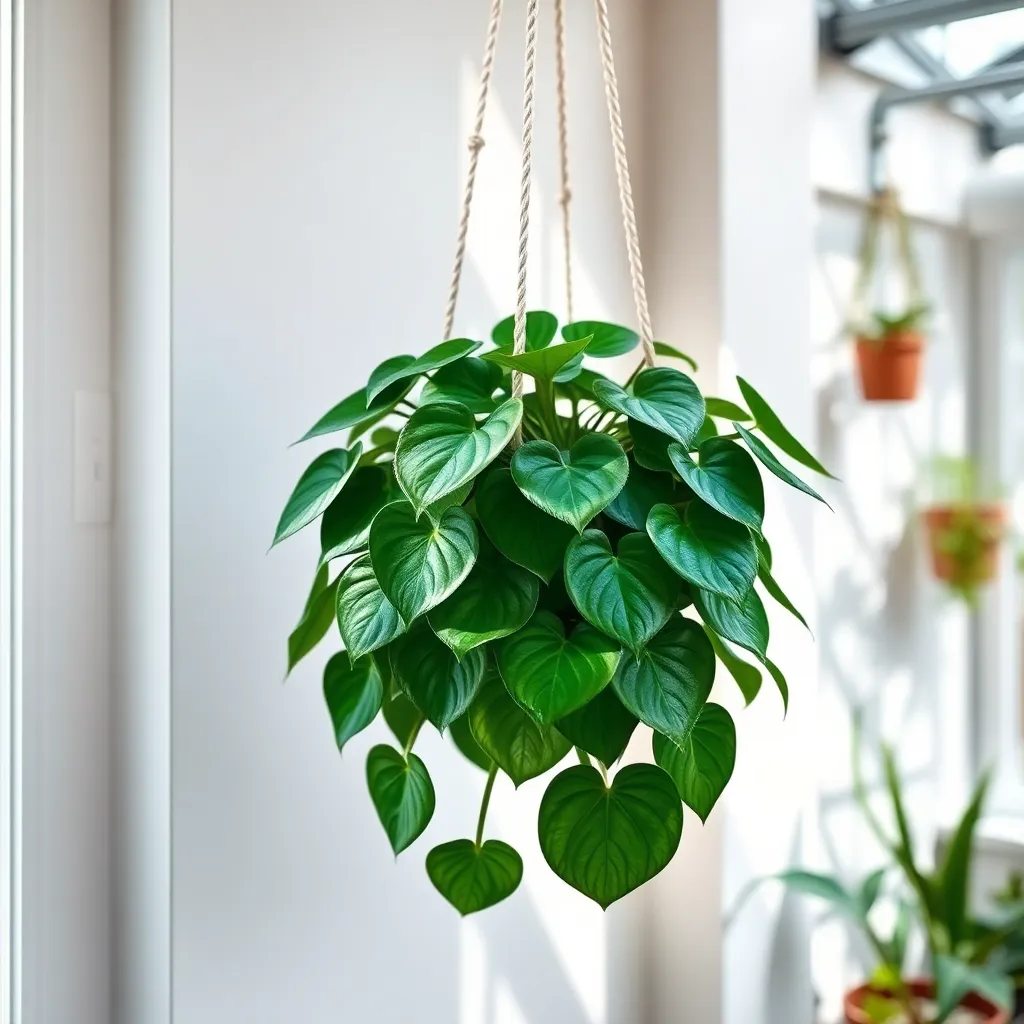
Heartleaf Philodendron is a popular choice for those looking to add lush, cascading greenery to their space. Known for its heart-shaped leaves and vigorous growth, this plant thrives in a variety of indoor settings.
To ensure your Heartleaf Philodendron flourishes, place it in a spot with indirect sunlight. Direct sunlight can scorch the leaves, so a north or east-facing window is ideal.
Watering is crucial, but it’s important not to overdo it. Allow the top inch of soil to dry out between waterings to prevent root rot, which is essential for keeping your plant healthy.
For optimal growth, use a well-draining potting mix, such as one formulated for aroids or general houseplants. If you’re looking to encourage more vigorous growth, consider fertilizing every other month with a balanced liquid fertilizer during the growing season.
Regular pruning will help maintain its shape and encourage bushier growth. Simply trim back any leggy vines and use the cuttings to propagate new plants, making it a great choice for creating a lush, green haven in your home.
Fuchsia: Colorful Blooms
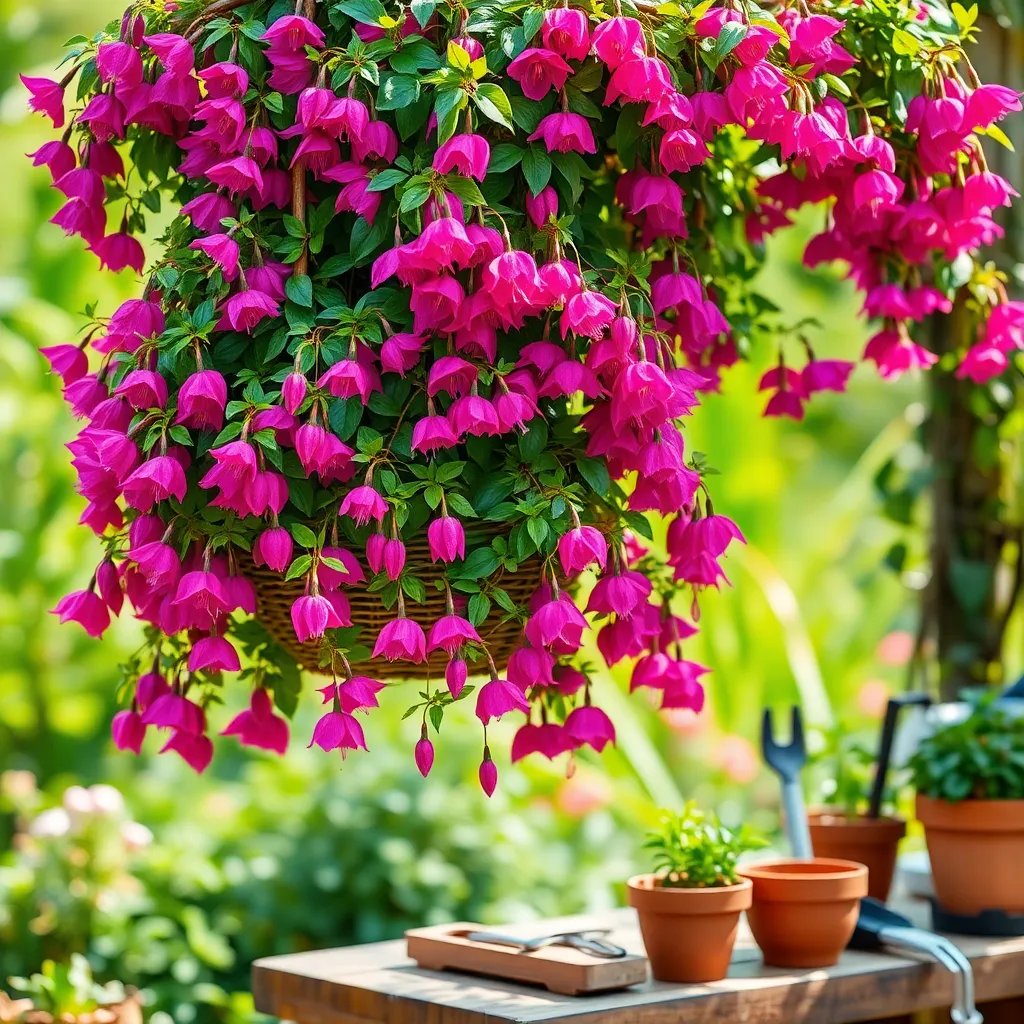
Fuchsias are beloved for their stunning, vibrant blooms that dangle elegantly, making them a perfect choice for hanging baskets. To thrive, fuchsias require a spot with partial shade, as too much direct sun can scorch their delicate flowers.
Ensure your fuchsias are planted in well-draining soil, as they prefer a consistently moist environment without being waterlogged. A soil mix that includes peat moss and perlite can help maintain the right balance of moisture and aeration.
Regular watering is crucial, especially during the growing season; aim to keep the soil evenly moist but not soggy. Fertilize every two weeks with a balanced, water-soluble fertilizer to encourage robust growth and prolific flowering.
For experienced gardeners, consider pinching back the growing tips to promote bushier growth and more abundant blooms. Additionally, watch for pests like aphids and spider mites, and treat them with insecticidal soap if necessary to keep your fuchsias looking their best.
Devil’s Ivy: Hardy and Hardy
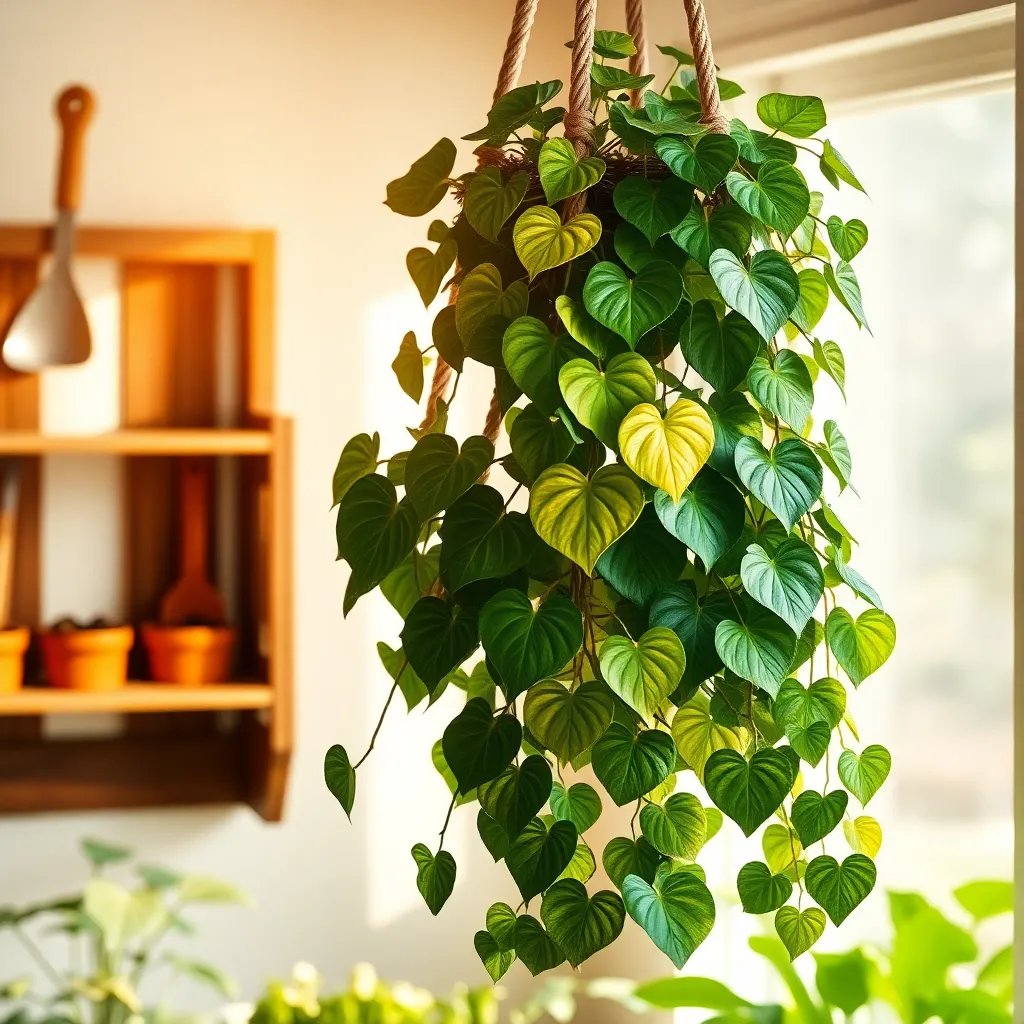
Devil’s Ivy, also known as Pothos, is a favorite among both novice and seasoned gardeners due to its resilience and lush foliage. This plant thrives in a range of lighting conditions, from low light to bright, indirect sunlight, making it versatile for any home setting.
To keep your Devil’s Ivy looking vibrant, water it when the top inch of soil feels dry to the touch. Overwatering is one of the few things that can harm this hardy plant, so ensure the pot has good drainage to prevent root rot.
For optimal growth, use a well-draining potting mix; a blend containing peat moss and perlite works exceptionally well. Fertilize your Devil’s Ivy every 4-6 weeks during the growing season with a balanced liquid fertilizer to encourage lush, trailing vines.
Advanced gardeners can propagate Devil’s Ivy easily by taking cuttings and rooting them in water or soil. This not only helps manage the plant’s size but also gives you new plants to share or expand your indoor garden.
Trailing Lobelia: Blue Blossoms
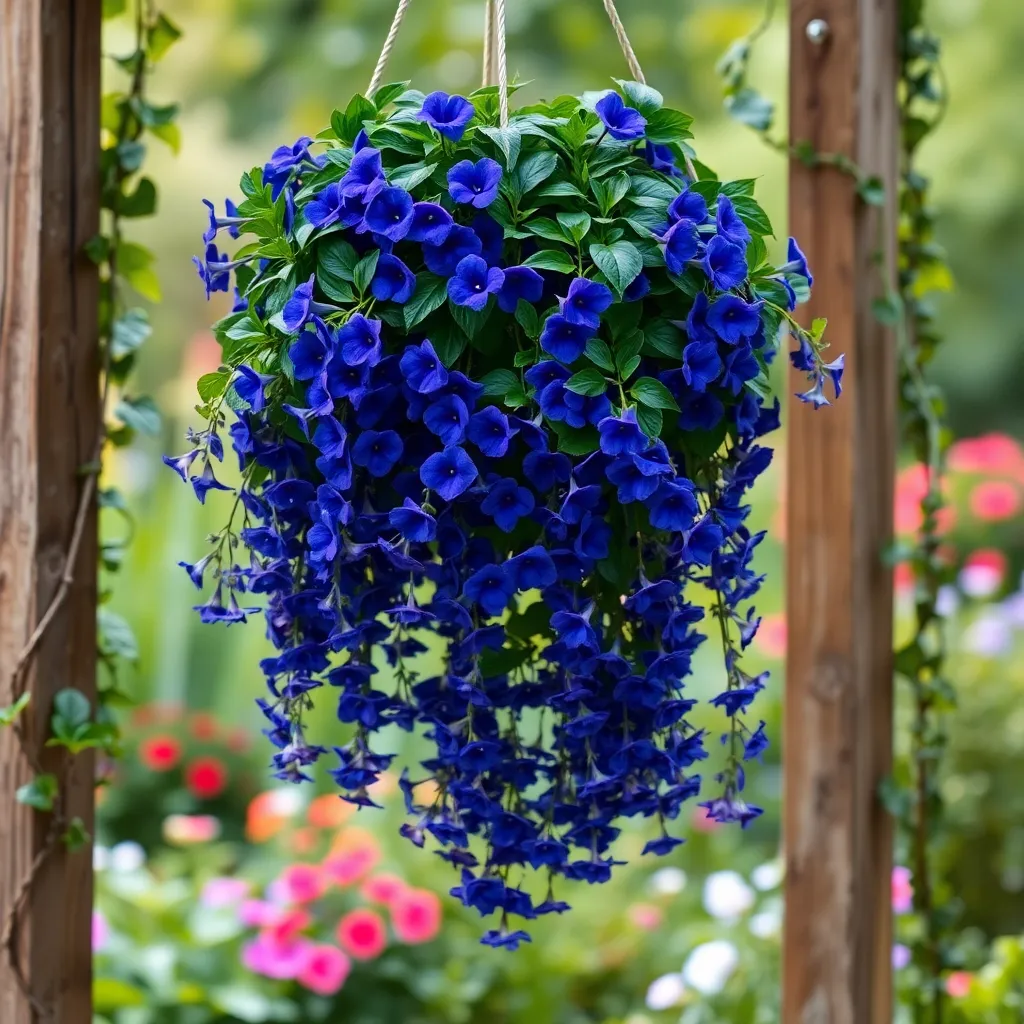
Trailing Lobelia, with its vibrant blue blossoms, can transform any hanging basket into a cascading spectacle of color. This charming plant thrives in well-draining soil, ideally a mix that is rich in organic matter to support its delicate root system.
To achieve lush growth, ensure your Lobelia receives partial shade, especially in hotter climates where the midday sun can be harsh. Regular watering is crucial—aim to keep the soil consistently moist but not waterlogged to prevent root rot.
For beginners, it’s helpful to know that Lobelia can be sensitive to heat, so consider positioning it where it will receive indirect light during the hottest parts of the day. Advanced gardeners might want to deadhead spent blooms to encourage continuous flowering and maintain the plant’s aesthetic appeal throughout the growing season.
Fertilize your Lobelia every two weeks with a balanced liquid fertilizer to promote vigorous growth and an abundance of blooms. Watch for pests like aphids, and manage them with an insecticidal soap if necessary, ensuring your plant remains healthy and vibrant.
Variegated Wandering Jew: Striking Foliage

The Variegated Wandering Jew, known for its striking foliage, is a vibrant addition to any hanging garden. With its unique combination of green, purple, and silver stripes, this plant is sure to catch the eye of anyone who visits your space.
For optimal growth, place your Variegated Wandering Jew in bright, indirect light to maintain its vivid colors. Direct sunlight can cause leaf burn, so ensure it receives the right balance of light throughout the day.
This plant thrives in well-draining soil; a mix of potting soil, perlite, and peat moss is ideal. Water consistently, allowing the top inch of soil to dry out between waterings, which helps prevent root rot and keeps the plant healthy.
Regular pruning is essential to encourage bushier growth and prevent legginess. Pinch back the stems every few weeks, and consider propagating cuttings in water for new plants, providing a rewarding way to expand your collection.
Hoya Carnosa: Wax Plant Magic
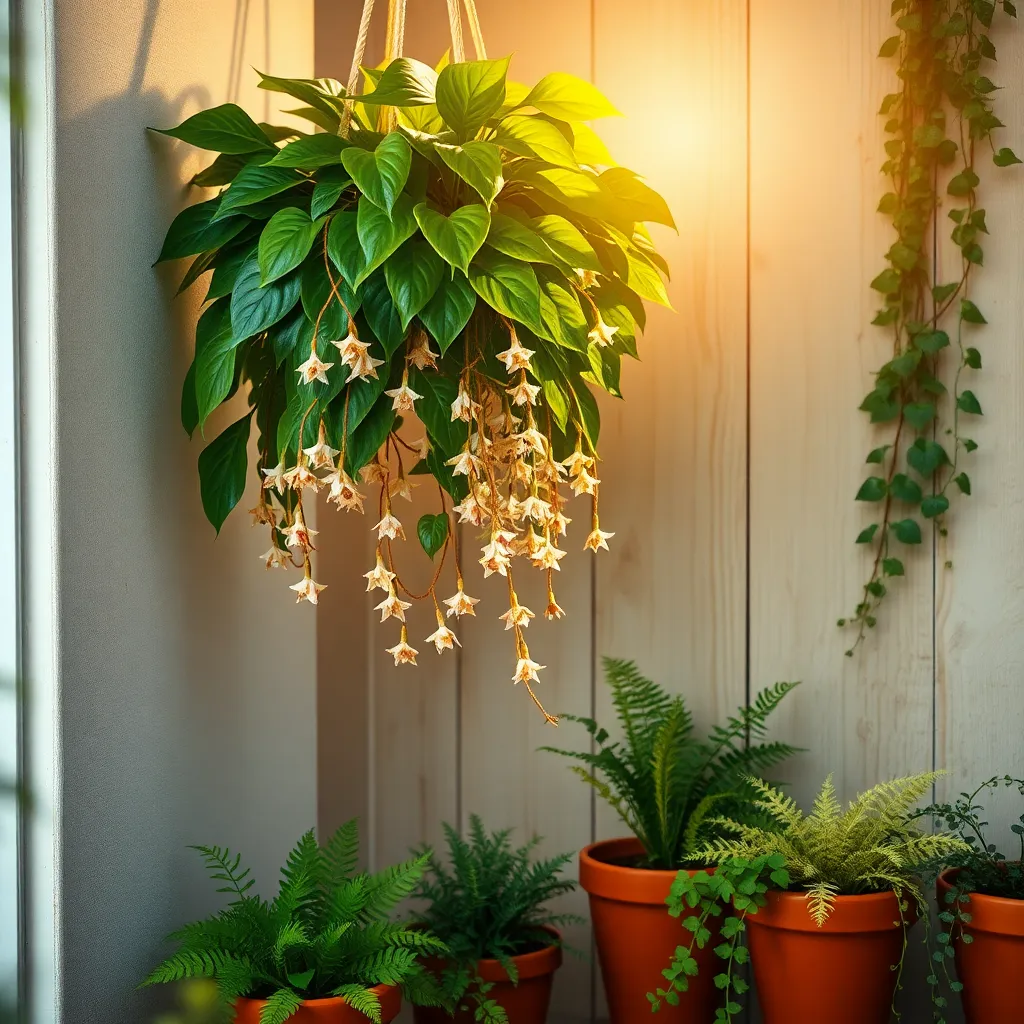
Known for its beautiful, star-shaped flowers, the Hoya Carnosa, or wax plant, can add a touch of magic to any hanging garden. Its lush, trailing vines are perfect for hanging baskets, making it a favorite among plant enthusiasts.
To help your Hoya Carnosa thrive, place it in a spot with bright, indirect light. Direct sunlight can scorch its leaves, so ensure the location is sheltered from harsh rays.
Watering should be done sparingly, allowing the top inch of soil to dry out between waterings. Overwatering can lead to root rot, so it’s crucial to maintain a balance.
For optimal growth, use a well-draining potting mix, such as one formulated for orchids or succulents. Regular feeding with a balanced liquid fertilizer every month during the growing season will keep your plant healthy and vibrant.
Light and Temperature Needs
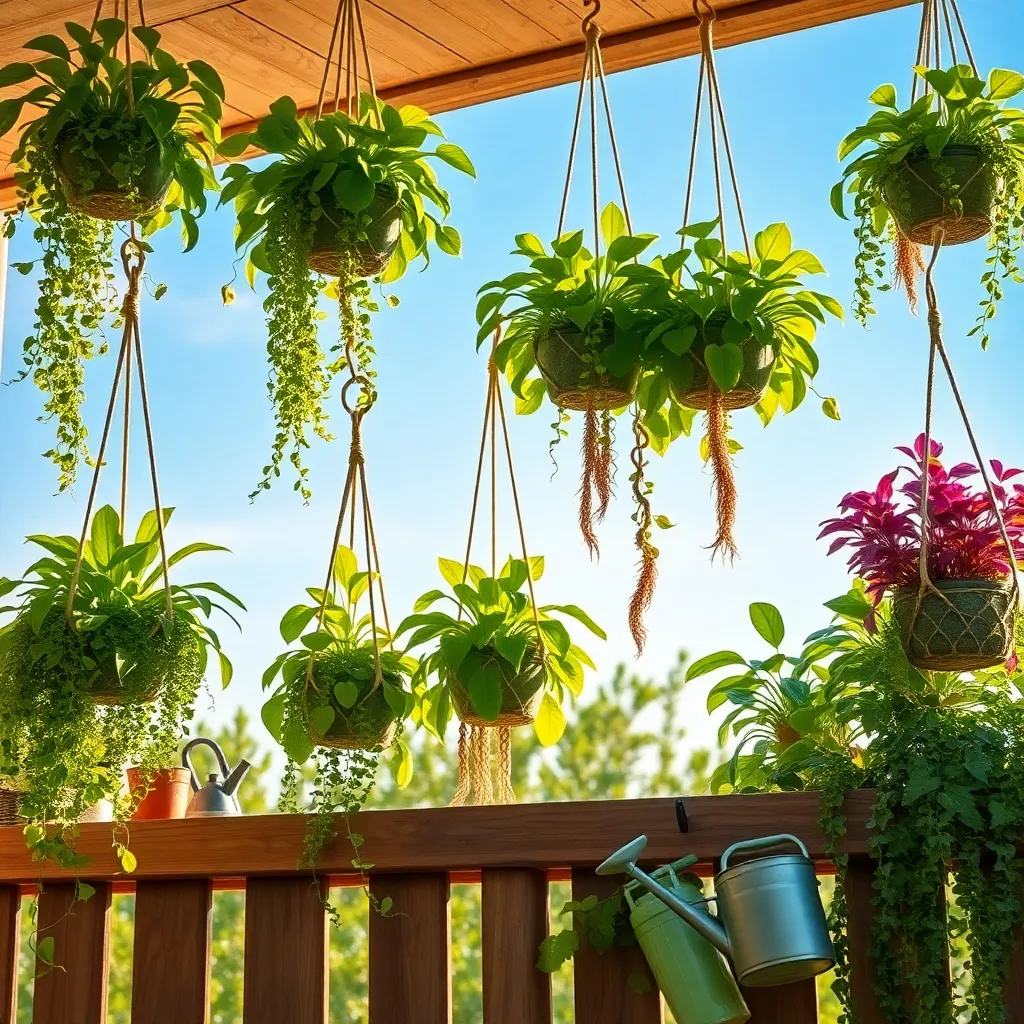
For many hanging plant varieties, understanding their light needs is crucial to their thriving. Most hanging plants prefer bright, indirect light, making them perfect for spaces near windows where they won’t be exposed to harsh sunlight.
Temperature can greatly affect the health of your hanging plants. It’s important to maintain a consistent environment, as many hanging plants flourish in temperatures ranging from 60°F to 75°F.
To ensure your plants receive adequate light without the risk of overheating, consider using sheer curtains or placing them slightly away from direct sunlight. If you notice the leaves looking scorched or bleached, it’s a sign that they’re receiving too much direct sunlight, and you should adjust their position.
During the colder months, keeping hanging plants away from drafty windows or heating vents is essential. This will help prevent sudden temperature fluctuations, which can stress the plants and hamper growth.
Advanced gardeners might consider supplementing natural light with grow lights during the winter to keep plants healthy. LED grow lights are energy-efficient and offer a spectrum that supports photosynthesis, helping maintain plant vitality year-round.
Caring for Your Hanging Plants

Caring for your hanging plants involves understanding their unique needs, which can differ from traditional potted plants. Since hanging plants are often more exposed, they require more frequent watering, especially in warm weather.
It’s essential to choose the right soil mix for your hanging plants to ensure they thrive. Opt for a lightweight, well-draining potting mix to prevent waterlogging and to keep the containers manageable.
Regular feeding is vital to maintain the lush growth commonly desired in hanging displays. Use a balanced liquid fertilizer every few weeks during the growing season to promote healthy foliage and vibrant blooms.
Pruning is another important aspect of keeping your hanging plants looking their best. Trim back any dead or damaged leaves and stems to encourage new growth and maintain a tidy appearance.
Advanced gardeners might consider rotating their hanging plants to ensure even light distribution, thus preventing uneven growth. Additionally, monitoring for pests like aphids or spider mites is crucial, as these can quickly spread in hanging setups.
Conclusion: Growing Success with These Plants
In exploring the ’18 Eye-Catching Hanging Plants Varieties You Can Grow,’ we’ve delved into the enriching parallels between nurturing plants and fostering thriving relationships. Each plant showcased, from the resilient spider plant to the graceful string of pearls, serves as a metaphor for essential relationship concepts—such as adaptability, patience, support, and growth. These insights remind us that, much like plants, relationships require dedicated care, understanding, and occasional pruning to flourish.
As a next step, identify one relationship in your life that could benefit from some ‘gardening.’ Whether it’s offering a listening ear or sprinkling in a bit of quality time, small, intentional actions can cultivate deeper, more meaningful connections.
Don’t miss out on these valuable lessons—bookmark this article to refresh your relationship toolkit whenever needed. By keeping these insights at your fingertips, you nurture the seeds of a successful relationship garden that can bloom beautifully over time.
Embrace this journey with an open heart, and remember, the relationships you cultivate today will become the vibrant, supportive networks that enrich your life tomorrow. Save this guide as your go-to resource for nurturing the bonds that matter most.

